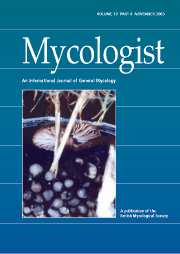Crossref Citations
This article has been cited by the following publications. This list is generated based on data provided by
Crossref.
2000.
21st Century Guidebook to Fungi.
p.
3.
Fomina, Marina
Burford, Euan P.
and
Gadd, Geoffrey M.
2006.
Fungi in Biogeochemical Cycles.
p.
236.
Fomina, M.
Charnock, J. M.
Hillier, S.
Alvarez, R.
and
Gadd, G. M.
2007.
Fungal transformations of uranium oxides.
Environmental Microbiology,
Vol. 9,
Issue. 7,
p.
1696.
Fomina, Marina
Charnock, John
Bowen, Andrew D.
and
Gadd, Geoffrey M.
2007.
X‐ray absorption spectroscopy (XAS) of toxic metal mineral transformations by fungi.
Environmental Microbiology,
Vol. 9,
Issue. 2,
p.
308.
Gadd, Geoffrey M.
Burford, Euan P.
Fomina, Marina
and
Melville, Karrie
2007.
Fungi in the Environment.
p.
77.
Tripathi, Pushplata
and
Srivastava, Sheela
2007.
Mechanism to combat cobalt toxicity in cobalt resistant mutants of Aspergillus nidulans.
Indian Journal of Microbiology,
Vol. 47,
Issue. 4,
p.
336.
Zapotoczny, Szczepan
Jurkiewicz, Anna
Tylko, Grzegorz
Anielska, Teresa
and
Turnau, Katarzyna
2007.
Accumulation of copper by Acremonium pinkertoniae, a fungus isolated from industrial wastes.
Microbiological Research,
Vol. 162,
Issue. 3,
p.
219.
Fomina, M.
and
Gadd, G. M.
2007.
Exploitation of Fungi.
p.
236.
Gadd, Geoffrey M.
2007.
Geomycology: biogeochemical transformations of rocks, minerals, metals and radionuclides by fungi, bioweathering and bioremediation.
Mycological Research,
Vol. 111,
Issue. 1,
p.
3.
Gadd, G.M.
2008.
Encyclopedia of Ecology.
p.
1709.
GADD, G. M.
2008.
Bacterial and fungal geomicrobiology: a problem with communities?.
Geobiology,
Vol. 6,
Issue. 3,
p.
278.
Lajili, H.
Devillers, P.
Grambin-Lapeyre, C.
and
Bournazel, J. P.
2008.
Alteration of a cement matrix subjected to biolixiviation test.
Materials and Structures,
Vol. 41,
Issue. 10,
p.
1633.
Campos, Juan A.
Tejera, Noel A.
and
Sánchez, Carlos J.
2009.
Substrate role in the accumulation of heavy metals in sporocarps of wild fungi.
BioMetals,
Vol. 22,
Issue. 5,
p.
835.
Gadd, Geoffrey Michael
2009.
Biosorption: critical review of scientific rationale, environmental importance and significance for pollution treatment.
Journal of Chemical Technology & Biotechnology,
Vol. 84,
Issue. 1,
p.
13.
Hong, J.W.
Park, J.Y.
and
Gadd, G.M.
2009.
Pyrene degradation and copper and zinc uptake byFusarium solaniandHypocrea lixiiisolated from petrol station soil.
Journal of Applied Microbiology,
Orive, A. González
Gimeno, Y.
Creus, A. Hernández
Grumelli, D.
Vericat, C.
Benitez, G.
and
Salvarezza, R.C.
2009.
Electrochemical preparation of metal–melanin functionalized graphite surfaces.
Electrochimica Acta,
Vol. 54,
Issue. 5,
p.
1589.
Ehrlich, Hermann
Demadis, Konstantinos D.
Pokrovsky, Oleg S.
and
Koutsoukos, Petros G.
2010.
Modern Views on Desilicification: Biosilica and Abiotic Silica Dissolution in Natural and Artificial Environments.
Chemical Reviews,
Vol. 110,
Issue. 8,
p.
4656.
Rooney, Deirdre C.
Hutchens, Elena
Clipson, Nicholas
Baldini, James
and
McDermott, Frank
2010.
Microbial Community Diversity of Moonmilk Deposits at Ballynamintra Cave, Co. Waterford, Ireland.
Microbial Ecology,
Vol. 60,
Issue. 4,
p.
753.
Gadd, Geoffrey M.
and
Raven, John A.
2010.
Geomicrobiology of Eukaryotic Microorganisms.
Geomicrobiology Journal,
Vol. 27,
Issue. 6-7,
p.
491.
Brake, Sandra S.
and
Hasiotis, Stephen T.
2010.
Eukaryote-Dominated Biofilms and Their Significance in Acidic Environments.
Geomicrobiology Journal,
Vol. 27,
Issue. 6-7,
p.
534.

